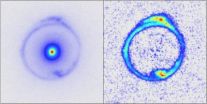Duke Medicine news -- Anti-cancer drug fights immune reaction in some infants with Pompe disease
2012-10-12
(Press-News.org) DURHAM, N.C. – Adding a third anti-cancer agent to a current drug cocktail appears to have contributed to dramatic improvement in three infants with the most severe form of Pompe disease -- a rare, often-fatal genetic disorder characterized by low or no production of an enzyme crucial to survival.
Duke researchers previously pioneered the development of the first effective treatment for Pompe disease via enzyme replacement therapy (ERT). ERT relies on a manufactured enzyme/protein to act as a substitute for the enzyme known to be lacking in patients with a particular disease. In Pompe disease, ERT has been found to reduce heart and muscle damage caused by the absence of the enzyme.
In the new study, appearing online in the Oct. 11, 2012, edition of the journal Genetics in Medicine, the Duke team added a new step to the therapeutic regimen to address complications suffered by a subset of infants with Pompe disease who are treated with ERT.
Some infants with Pompe disease who have certain combinations of genetic mutations develop a severe immune response to ERT. Very high levels of antibodies become directed against the enzyme and greatly reduce its therapeutic effect, leading to rapid clinical decline and death.
In a January 2012 publication in Genetics in Medicine, the researchers reported success in preventing the immune rejection in Pompe infants who were just beginning ERT. They treated them with a drug cocktail that included low doses of the cancer chemotherapy drugs rituximab and methotrexate, plus the immune booster gammaglobulin to prevent the immune response to the ERT.
The three cases described in the new paper had already received the ERT for a prolonged period of time and, despite initial improvements, declined rapidly as their bodies developed high levels of antibodies that blocked the effect of the enzyme replacement. In these youngsters, plasma cells, which are the ultimate source of antibody production, were left untouched by the immune-suppressing drug cocktails.
"These plasma cells form rapidly after exposure to ERT, and some of them are what we call long-lived plasma cells that survive for years, continuing to spew out antibodies," explained senior author Priya Kishnani, M.D., professor of Pediatrics and Medical Genetics at Duke.
After testing their ideas in mouse models of Pompe disease, the Duke researchers added a proteasome inhibitor called bortezomib to the regimen. Bortezomib, which is FDA-approved to treat multiple myeloma and mantle cell lymphoma, targets the plasma cells and inhibits the production of antibodies, reversing the established immune response.
In all three cases the antibodies decreased rapidly. Just as rapidly, each of the babies' conditions dramatically improved and the babies have continued to do well.
"I'm absolutely delighted, because to me this has become life-saving for these fragile babies," Kishnani said. "This is what I truly think is translational research, where you learn about a problem in patients, address it in an animal model and take it back into the patients to make a difference."
"We were encouraged with the positive results from preclinical studies using bortezomib. We quickly developed a clinical protocol using bortezomib for infantile Pompe patients that had failed conventional treatment. It was truly a satisfying experience," said first author Suhrad Banugaria, MBBS, postdoctoral associate in Pediatrics Medical Genetics at Duke.
Next, the group is working to develop treatments that more specifically target antigens eliciting immune responses to ERT. Kishnani and colleagues hope that such a targeted approach might minimize the impact on the immune system generally.
Kishnani said the insights her team has gained treating Pompe disease could be applied to other diseases in which an immune response has also been shown to reduce the impact of enzyme replacement therapy.
"We're already getting calls for other conditions such as mucopolysaccharidosis and Fabry disease, where physicians are facing the same issues: patients who have developed a significant antibody response and are not doing as well, or have started to show a clinical decline," Kishnani said.
###
In addition to Kishnani and Banugaria, authors include Sean N. Prater, Duke Department of Pediatrics; Judeth K. McGann, Jonathan D. Feldman, and Jesse A. Tannenbaum of Kaiser Permanente, Santa Clara, Cal.; Carrie Bailey and David Viskochil of the University of Utah; Renuka Gera and Robert L. Conway of Michigan State University; Joyce A. Kobori of Kaiser Permanente, San Jose, Cal.; and Amy S. Rosenberg of the U.S. Food and Drug Administration, Bethesda, Md.
Kishnani reports receiving research support, honoraria and consulting fees from Genzyme, which markets an ERT for Pompe disease. Duke University and the inventors of the method of treatment and precursors of the cell lines used to generate the enzyme (rhGAA) used commercially have received royalties pursuant to the university's policy on inventions, patents, and technology transfer. This potential conflict has been resolved through monetization. Full dislosures of conflicts are listed in the manuscript.
Click on link for a conceptual diagram of the immune response: http://www.dukehealth.org/pompe-disease-graphic
ELSE PRESS RELEASES FROM THIS DATE:
New studies reveal connections between animals' microbial communities and behavior
2012-10-12
Athens, Ga. – New research is revealing surprising connections between animal microbiomes—the communities of microbes that live inside animals' bodies—and animal behavior, according to a paper by University of Georgia ecologist Vanessa O. Ezenwa and her colleagues. The article, just published in the Perspectives section of the journal Science, reviews recent developments in this emerging research area and offers questions for future investigation.
The paper grew out of a National Science Foundation-sponsored workshop on new ways to approach the study of animal behavior. ...
Enzyme triggers cell death in heart attack
2012-10-12
University of Iowa researchers have previously shown that an enzyme called CaM kinase II plays a pivotal role in the death of heart cells following a heart attack or other conditions that damage or stress heart muscle. Loss of beating heart cells is generally permanent and leads to heart failure, a serious, debilitating condition that affects 5.8 million people in the United States.
Now the UI team, led by Mark Anderson, M.D., Ph.D., professor and head of internal medicine at the UI Carver College of Medicine, has honed in on how CaM kinase II triggers heart cell death ...
New treatments for epilepsy, behavioral disorders could result from Wayne State studies
2012-10-12
Three studies conducted as part of Wayne State University's Systems Biology of Epilepsy Project (SBEP) could result in new types of treatment for the disease and, as a bonus, for behavioral disorders as well.
The SBEP started out with funds from the President's Research Enhancement Fund and spanned neurology, neuroscience, genetics and computational biology. It since has been supported by multiple National Institutes of Health-funded grants aimed at identifying the underlying causes of epilepsy, and it is uniquely integrated within the Comprehensive Epilepsy Program at ...
Safety results of intra-arterial stem cell clinical trial for stroke presented
2012-10-12
HOUSTON – (Oct. 11, 2012) – Early results of a Phase II intra-arterial stem cell trial for ischemic stroke showed no adverse events associated with the first 10 patients, allowing investigators to expand the study to a targeted total of 100 patients.
The results were presented today by Sean Savitz, M.D., professor of neurology and director of the Stroke Program at The University of Texas Health Science Center at Houston (UTHealth), at the 8th World Stroke Congress in Brasilia, Brazil.
The trial is the only randomized, double-blind, placebo-controlled intra-arterial clinical ...
Satellite sees 16th Atlantic tropical depression born near Bahamas
2012-10-12
The 16th tropical depression of the Atlantic Ocean season has formed northeast of the Bahamas and NOAA's GOES-14 satellite captured a visible image of the storm as it tracks to the southwest.
NOAA's GOES-14 satellite captured a visible image of newborn Tropical Depression 16 (TD16) near the Bahamas on Oct. 11 at 7:45 a.m. EDT. TD16 appeared as a rounded area of clouds just northeast of the Bahamas and its western fringes were just off the Florida east coast. GOES-14 also showed another low pressure area with the potential for development a few hundred miles from the Windward ...
NASA sees Typhoon Prapiroon doing a 'Sit and Spin' in the Philippine Sea
2012-10-12
As Typhoon Prapiroon slowed down and became quasi-stationary in the Philippine Sea NASA's Terra satellite passed overhead and captured an image of the storm.
NASA's Terra satellite passed over Typhoon Prapiroon on Oct. 11 at 0210 UTC (1010 p.m. EDT, Oct. 10) and the Moderate Resolution Imaging Spectroradiometer (MODIS) instrument captured a visible image of the storm. The visible imagery clearly showed a small ragged eye, and microwave satellite imagery confirmed the eye. Satellite imagery also confirmed a well-defined low-level center of circulation.
By 11 a.m. EDT ...
Nurture trumps nature in study of oral bacteria in human twins, says CU study
2012-10-12
A new long-term study of human twins by University of Colorado Boulder researchers indicates the makeup of the population of bacteria bathing in their saliva is driven more by environmental factors than heritability.
The study compares saliva samples from identical and fraternal twins to see how much "bacterial communities" in saliva vary from mouth to mouth at different points in time, said study leader and CU-Boulder Professor Kenneth Krauter. The twin studies show that the environment, rather than a person's genetic background, is more important in determining the ...
When galaxies eat galaxies
2012-10-12
SALT LAKE CITY, Oct. 11, 2012 – Using gravitational "lenses" in space, University of Utah astronomers discovered that the centers of the biggest galaxies are growing denser – evidence of repeated collisions and mergers by massive galaxies with 100 billion stars.
"We found that during the last 6 billion years, the matter that makes up massive elliptical galaxies is getting more concentrated toward the centers of those galaxies. This is evidence that big galaxies are crashing into other big galaxies to make even bigger galaxies," says astronomer Adam Bolton, principal ...
Exposure to traffic air pollution in infancy impairs lung function in children
2012-10-12
Exposure to ambient air pollution from traffic during infancy is associated with lung function deficits in children up to eight years of age, particularly among children sensitized to common allergens, according to a new study.
"Earlier studies have shown that children are highly susceptible to the adverse effects of air pollution and suggest that exposure early in life may be particularly harmful," said researcher Göran Pershagen, MD, PhD, professor at the Karolinska Institutet Institute of Environmental Medicine in Stockholm, Sweden. "In our prospective birth cohort ...
Quiz, already used in elderly, could determine death risk for kidney dialysis patients of all ages
2012-10-12
A simple six-question quiz, typically used to assess disabilities in the elderly, could help doctors determine which kidney dialysis patients of any age are at the greatest risk of death, new Johns Hopkins research suggests.
Believing that kidney failure mimics an accelerated body-wide aging process transplant surgeon Dorry L. Segev, M.D., Ph.D., and his colleagues turned to geriatric experts to examine mortality risk in patients undergoing dialysis. They found that those who needed assistance with one or more basic activities of daily living – feeding, dressing, walking, ...


